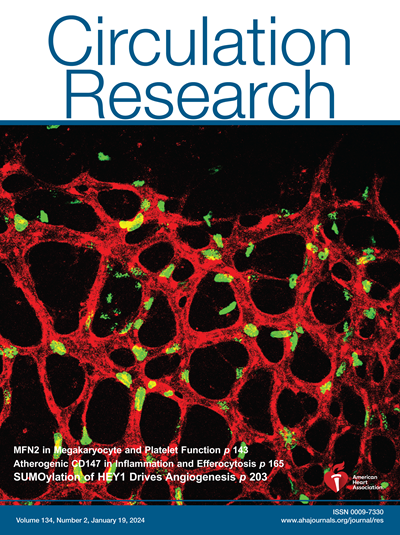Immunoregulatory Endothelial Cells Interact With T Cells After Myocardial Infarction.
IF 16.2
1区 医学
Q1 CARDIAC & CARDIOVASCULAR SYSTEMS
引用次数: 0
Abstract
BACKGROUND Endothelial cells (ECs) play pivotal roles in maintaining cardiac blood supply and regulating inflammation by acting as gatekeepers for immune cell activity. This study unveils a novel immunomodulatory function of cardiac ECs following myocardial infarction. METHODS We used single-cell RNA sequencing and spatial transcriptomics to identify EC states after acute myocardial infarction in mice. Subsequently, we mimicked the cytokine environment that was predicted to induce EC activation in cell culture studies and confirmed the results in an endothelial-specific deletion mouse model. RESULTS Single-cell RNA sequencing analysis identified a transient myeloid CD45+CD11b+Cdh5+ immunomodulatory EC phenotype (IMEC) emerging between days 1 and 3 after myocardial infarction. IMECs derived from Cdh5+ tissue resident cells as shown by bone marrow transplantation and lineage tracing experiment. Ligand-receptor interaction predictions indicated a cytokine-mediated activation of IMECs, which we validated through in vitro experiments in cultured ECs. Notably, while cytokine treatment with IL-1β (interleukin 1β) and TGF-β (transforming growth factor β) induced mesenchymal gene expression, the addition of IFN-γ (interferon γ) facilitated the transition into the immunomodulatory phenotype. IMECs exhibited an upregulation of MHC-II (major histocompatibility complex class II) genes, along with the expression of RUNX1 and proinflammatory cytokines, such as IL-6 and IL-12. IMECs induced T-cell activation through paracrine signaling and were colocalized with T cells in vivo. Inhibition of endothelial-specific IFN-γ-signaling in mice by IFN-γ receptor 1 deletion improved the recovery after myocardial infarction. CONCLUSIONS These findings provide insight into the role of ECs regulating adaptive immune responses following myocardial infarction, offering potential insights into therapeutic interventions for postinfarction immunomodulation.心肌梗死后免疫调节内皮细胞与T细胞相互作用
内皮细胞(ECs)作为免疫细胞活性的看门人,在维持心脏血液供应和调节炎症方面发挥着关键作用。这项研究揭示了心肌梗死后心肌内皮细胞的一种新的免疫调节功能。方法采用单细胞RNA测序和空间转录组学方法对小鼠急性心肌梗死后的EC状态进行鉴定。随后,我们模拟了细胞培养研究中预测的诱导EC激活的细胞因子环境,并在内皮特异性缺失小鼠模型中证实了这一结果。结果单细胞RNA测序分析发现,心肌梗死后第1天至第3天出现短暂性髓系CD45+CD11b+Cdh5+免疫调节EC表型(IMEC)。骨髓移植和谱系追踪实验表明,imec来源于Cdh5+组织驻留细胞。配体-受体相互作用预测表明细胞因子介导的IMECs活化,我们通过体外培养的ECs实验验证了这一点。值得注意的是,当细胞因子IL-1β(白细胞介素1β)和TGF-β(转化生长因子β)诱导间充质基因表达时,IFN-γ(干扰素γ)的加入促进了向免疫调节表型的转变。imec表现出MHC-II(主要组织相容性复合体II类)基因的上调,以及RUNX1和促炎细胞因子如IL-6和IL-12的表达。IMECs通过旁分泌信号诱导T细胞活化,并在体内与T细胞共定位。IFN-γ受体1缺失对小鼠内皮特异性IFN-γ信号传导的抑制促进心肌梗死后的恢复。结论这些发现为心肌梗死后ECs调节适应性免疫反应的作用提供了新的视角,为梗死后免疫调节的治疗干预提供了潜在的见解。
本文章由计算机程序翻译,如有差异,请以英文原文为准。
求助全文
约1分钟内获得全文
求助全文
来源期刊

Circulation research
医学-外周血管病
CiteScore
29.60
自引率
2.00%
发文量
535
审稿时长
3-6 weeks
期刊介绍:
Circulation Research is a peer-reviewed journal that serves as a forum for the highest quality research in basic cardiovascular biology. The journal publishes studies that utilize state-of-the-art approaches to investigate mechanisms of human disease, as well as translational and clinical research that provide fundamental insights into the basis of disease and the mechanism of therapies.
Circulation Research has a broad audience that includes clinical and academic cardiologists, basic cardiovascular scientists, physiologists, cellular and molecular biologists, and cardiovascular pharmacologists. The journal aims to advance the understanding of cardiovascular biology and disease by disseminating cutting-edge research to these diverse communities.
In terms of indexing, Circulation Research is included in several prominent scientific databases, including BIOSIS, CAB Abstracts, Chemical Abstracts, Current Contents, EMBASE, and MEDLINE. This ensures that the journal's articles are easily discoverable and accessible to researchers in the field.
Overall, Circulation Research is a reputable publication that attracts high-quality research and provides a platform for the dissemination of important findings in basic cardiovascular biology and its translational and clinical applications.
 求助内容:
求助内容: 应助结果提醒方式:
应助结果提醒方式:


